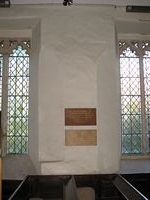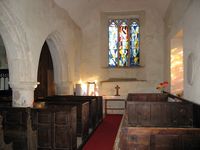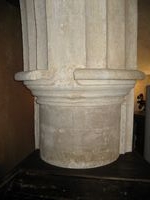| INSIDE |

Welcome inside St. Mary's Church!
As you enter you will pass the side chapel in the south aisle, before finding yourself in the nave looking east towards the chancel and communion table.
It is worth stopping to remember that for at least 900 years, thousands of villagers have come here to worship God!
View of nave & chancel
South aisle & side chapel
Beneath it would have been a screen dividing the chancel from the nave, with a loft (gallery) built above for the lighting of candles and the saying of masses in front of the rood. The steps up to the gallery have been blocked in but the entrance to the right of the window can be clearly seen in the plaster. If you look at the wall outside you can see where there would have been a turret.
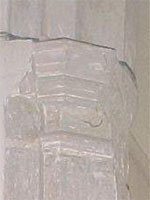
In
1962 Dr. Welton (Rector at the time) claimed Hinderclay was the only parish
church in England to have such a piscina. We are not sure if this is accurate.
The
existing square-headed screen is a late example, with its open tracery
and moulded mullions (uprights) but some of the panels are much older.
It is thought that it originally
stood in St. Nicholas' Church, Thelnetham and their Vestry Notes for Easter
Monday, 1907, record that the plans for their new screen were almost complete.
The Rev. Sawbridge gave the old screen to Hinderclay when the new screen
was installed - presumably in 1908. We know from a study of the church
in 1848 that a screen was already present.
The pulpit and lectern are of a basic wooden design. It is thought the pulpit was originally on the north side of the nave, between the two easterly windows, shown in the photograph on the right. This would account for the seats in the south aisle box pews facing north. It was probably moved when the church was re-arranged in 1848.
The wall appears to have had the corners removed and the small ledge on the left could have been used to house a statue. High up there is evidence of damage to the wall - probably caused when the pulpit was removed.
The two plaques in the picture are for Edwin Aves and Canon John Aves.
Near the archway leading to the tower is St. Mary's octagonal 14th C font. It is still in use today and has been used to christen many hundreds of infants over the years.
We know that in 1848 the font was positioned in front of the sealed door, where the war memorial now is.
Behind the font you
can see the lower half of the tower arch, which is filled with 18th
C paneling, as is that of the vestry.
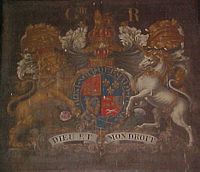
On the 23rd April, 1979 the annual Vestry Minutes record the possibility that the Organ from the redundant church of Rickinghall Superior might be brought to Hinderclay. No mention was made of it in subsequent years so it is assumed it arrived sometime later in 1979. It was installed in memory of Edwin John Aves. The organ had originally been pumped by hand but in 1962 an electric pump had been added. There is a wooden plaque on the organ which reads:
"A
M D G and in memory of Reginald Paulet Paynter. |
On the south of the south aisle are three large family pews.
There is evidence that the South Aisle was once enclosed. If the two pillars between the Nave and South Aisle are studied it can be seen that there are pieces broken off where a wooden screen could have been inserted. The enclosed area would have been used by St. Peter's Guild as a Guild Chapel. The Chantry Priest would have said prayers for the souls of the departed there. It is thought the pillars are Norman and date from about the year 1225.
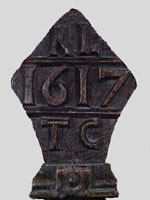
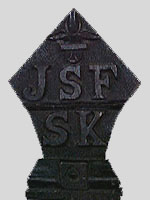
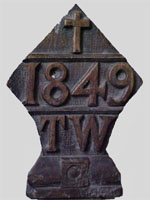
The diamond - shaped poppy heads on the pews near the back of the church bear a variety of rosettes & fleurs-de-lys. It is thought that the letters RL, TC, TW, JSF, and SK on the poppy heads are the initials of the Church-wardens at the time.
On the south wall is a modern oval memorial tablet to Charlotte Doe (1833-1917).
She
was born here in Hinderclay but served as a Nanny for 51 years
to a family in Roehampton, Surrey. She is described as a 'devoted Nurse
and faithful friend of the family'.
The tablet was erected "by their two daughters and six sons who owe more than they can ever repay to her love and care".
One of the daughters was Lady Muriel Buxton, who was the grandmother of the present Duke of Grafton.
Also on the north wall of the chancel is an interesting marble memorial to George Thompson. He was Rector at St. Mary's for only a year before he died in November 1711.
At the top there
is a cartouche of arms with three choughs (type of crows), supported
by garlands, standing putti (cherub boys) at each side, and cherub heads
with wings and acanthus leaves below.
In the tower there are six bells hung in an iron frame: the treble, cast by Thomas Osborn of Downham Market in 1790, has the inscription 'Cum Voco Venite' (come with voice); the second and fifth were cast by Thomas Gardiner of Sudbury in 1716 and 1734; the third, cast by Roger Reve of Bury St. Edmunds in the period 1527-33, has the inscription 'sancta caterina ora pro nobis' (St. Catharine pray for us); the fourth bell of 1621 was a joint effort by John Draper of Thetford and Andrew Gurney, probably of Bury; and the Tenor, which weighs over 10 cwt., was probably cast by Richard Brasyer I who was active between 1424 and 1482, and has the inscription 'Nos Thome Meritis Mercamur Gaudia Lucis' (may we be led by the merits of Thomas into the joys of light). In 1461 John Samson left £6-13s-4d in his will and it is thought it may have been used to buy this bell.
Some villagers remember the bells being re-hung in the 1940s.
The bells continue to ring out on Monday evenings and on special occasions.
'By
Sam Moss this Pitcher was given to the Noble Society of Ringers at Hendercley
in Suffolk (viz.) Thos Sturgeon Edwd Lock John Hans Rich Ruddock &
Ra Chapman To which Society he once belonged 7 years and left in y one
thousand seven hundard & 2 From London I was sent As plainly
does appear It was with this intent To be fild with strong beer Pray remember
the pitcher when empty.'
On the bottom of the pitcher is inscribed '25 March 1724'. The gotch,
together with the exterior of the church, appears on the Village
Sign, which stands by the crossroads in the village. The 'Gotch' is
now on permanent loan and can be viewed at Moyses Hall Museum in Bury
St. Edmunds
As with all the fine historic churches of England, St. Mary's Hinderclay reflects the zeal and devotion of Christians through the centuries who have lovingly built and maintained it for the worship of God.
Our prayer is that you, the reader of these web pages, may sense the presence of God here and may also come to know Him personally.
